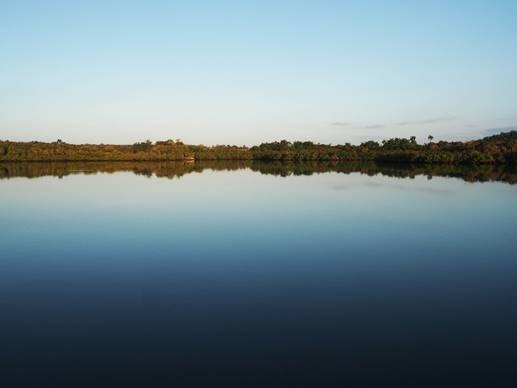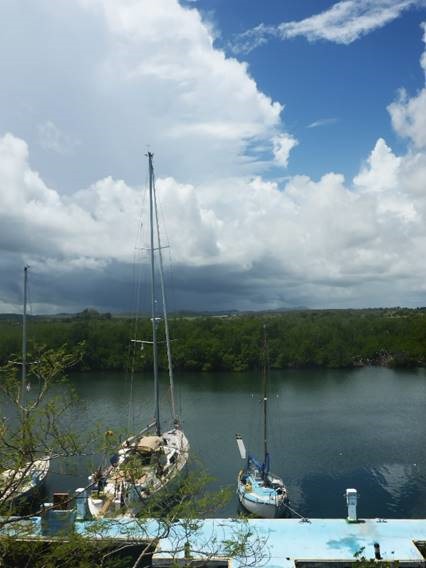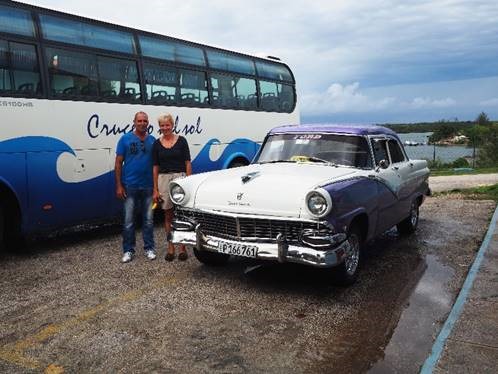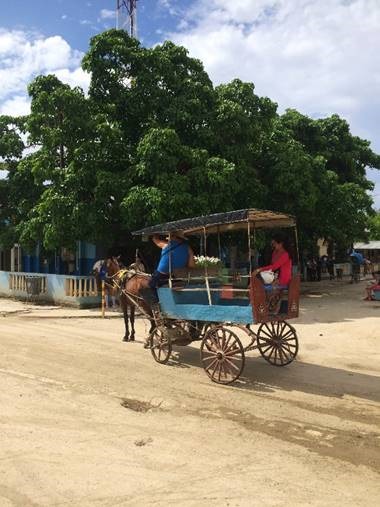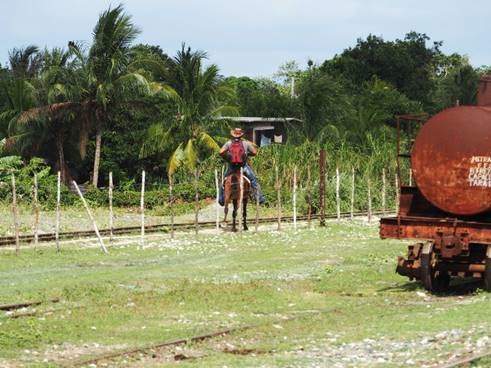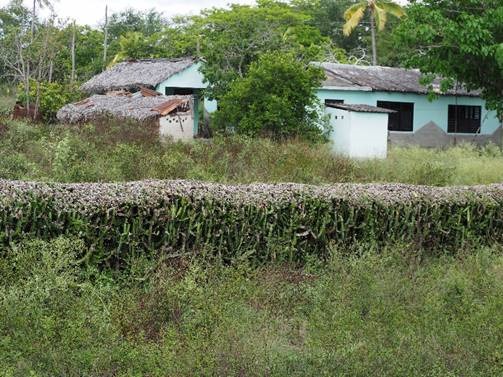3 May - an introduction to Cuba

|
21:04.3N 075:57.3W
So we sailed for Cuba at sunset on 1 May. That night, the wind rose from the north east, gradually veered into the east and the seas got rougher. We were perfectly safe but quite uncomfortable with a quartering sea making the boat roll. Faced with the prospect of a few days without much sleep if we pushed on towards Havana, we decided to divert to the port of Puerto de Vita on the north east coast of Cuba. It is one of only three ports on the northern shore where foreign vessels can make a landfall legally, because the Cuban authorities like to control their coastline very carefully.
I sense that they are wary of foreigners bringing unwelcome goods or people in, or assisting islanders to emigrate without the correct paperwork. We had read about this in the Pilot Books and guides and if you don’t like the restrictions, then don’t come to Cuba!
Puerto de Vita with an afternoon thunderstorm brewing
We made radio contact with the authorities at Puerto de Vita about two hours before we arrived off the harbour entrance. They were professional and polite; as we turned into wind to lower our sails by the huge modern lighthouse at Punta Barloventa, they called us up to reassure us that the entrance was close by. I explained that we were simply lowering our sails before entering, but it was interesting to note that they were monitoring our progress on AIS: they proceeded to provide a slightly unnecessary virtual pilotage service all the way into the anchorage, about three miles up the estuary. It is very well marked with buoys and transit marks and the depths were never less than 5m in the main part of the channel. The shoreline was a low sandstone ledge with a mix of mangroves and other scrubland, interspersed with rather poor looking pasture and the occasional herd of oxen. No people, no buildings, plenty of birdlife, blissfully quiet. We turned into a larger bay where the small settlement of Puerto de Vita lies and saw the buildings of the Guarda Frontera and the Marina (run by a branch of the Armed Forces that delivers tourism to foreigners – something for the RAF to consider, perhaps?). We were directed to anchor for the night and await the arrival of the Guarda Frontera at 0700 the following morning. We were the only boat in the bay, though we could see a couple of others berthed in the small marina.
All clear by dawn. At anchor, waiting for Cuban officials
We were ready to be boarded at 0645, but nobody arrived until 0945 when a chap from the marina came out and directed us to go alongside to allow the officials onboard. Our charts suggested that there was not enough water for us, but he was insistent, so we decided to comply. The anchor came up slowly, covered in really thick, smelly mud, but the rest of the evolution went smoothly. There was never less than 4m in the approach to the berth and we dropped our anchor some 40m off the pier, before reversing in and tying the stern to the concrete structure. It looked well built, safe and very well sheltered.
The marina berth was well sheltered and very secure
Ten minutes later, a doctor from the Health Ministry arrived to check our wellbeing. Dr Rolando is an epidemiologist at the local hospital in the daytime, administering to the local district, doing some teaching and working for the Guarda Frontera when required by the arrival of vessels from overseas. He spoke good English, was utterly professional and very engaging. He took our temperatures, which were normal, then we filled in quite a lot of paperwork. He asked for a copy of the boat Registration Papers to help speed things up with the Guarda Frontera and his eyes popped out when Julie produced our tiny Canon inkjet printer and hooked it up to a laptop. ‘Ah, the developed world’ he commented. He had not seen anything so sophisticated and was especially impressed that it was a colour printer; I reassured him that at least his 1980s dot matrix thing that had its own room in the hospital was easy to fix!
Customs and the Guarda Frontera followed. They took photos of just about everything, wrapped our satellite phone handset and handheld GPS in sealed bags and had a cursory look around. We filled in more paperwork, some of it a repeat of the medical visit. Sniffer dogs looking for drugs and guns came and went. All professional, polite and efficient, if rather bureaucratic. After all, my mobile phone has a GPS and a camera in it, so why didn’t that disappear into a sealed bag too? They issued us with Visas and the necessary Cruising Permit for the boat without demanding any money: we were to pay that to the marina staff along with the mooring fees. Lastly, staff from the Ministry of Agriculture came to check our fridge contents – they peered at our few packets of meat and passed us as safe.
So, once we were allowed ashore, we filled in some more paperwork at the Marina office. They did not want money either – in fact, we were immediately given a ‘tab’ at the restaurant and the shop for anything we wanted (assuming you wanted rum or Edam cheese!). As we had no Cuban pesos, they arranged for a taxi to take us into the nearby town of Raphael Freyre, where we could visit the bank and take advantage of the wifi hotspot there. The Internet is not widely available in Cuba: there was a machine we could use in the marina office, but if we wanted to use our own devices, a trip to town was essential.
The Marina Office at Puerto de Vita has a fine view – not a boat in sight!
We had a good, simple lunch in the restaurant and then met the taxi. What a delight! A highly polished 1957 Ford Fairlane driven by Ronaldo, a quietly spoken, smiling Cuban with filmstar looks. We went through the marina gates and stepped straight into the New Forest of the 1940s.
Cuban wheels…
The horse is a major part of the transport network here, split between gauchos with large sombreros and red kerchiefs round their neck wielding lassos and proper Cuban heels, horses pulling carts moving farming folk and their produce, or horse-drawn taxis (the majority). A third of the cars are American pre-1959, most highly painted and used as taxis, some rather tatty but still running. A third are Ladas and Moskvichs from the 1970s and the remainder are more modern Chinese imports. The buses are Chinese and pretty frequent; relatively few people have access to a private vehicle of any description. The houses are small, but mostly well built and in reasonable condition. As we neared the rural town of Raphael Freyre, the odd apartment block in the Soviet style appeared, but for the most part it looks like a rather shabby European colony.
Taxi, Cuban style
There are animals everywhere – more pigs than we’ve seen elsewhere in the Caribbean, cockerels and hens, a few goats, plenty of oxen. The dogs are either well fed farming animals, or strays that look close to death. The hedgerows are closely cropped cactus – an efficient, self-sustaining barrier that will keep most animals at bay! The fields are tended by hand: we saw very few tractors and ploughing is done with oxen. Fertiliser looked to be in short supply and drainage quite poor. Whilst everything belongs to the workers cooperatives, people are allowed to sell some stuff privately and there were little stalls selling mangoes and other fruit at regular intervals along the road. The quality was average to poor, but the prices unbelievably cheap.
The town of Raphael Freyre would be about the size of Lee on Solent, I suppose. It seemed very Third World. There are few shops selling anything; those that were open tended to focus on a few things and a strange mix – a ‘supermarket’ had no fresh food whatsoever, a few tins, some oil, no rice, some cheap imported Chinese clothing and kitchen equipment. We bought vegetables from a roadside stall; the vendor was amazed that we didn’t want potatoes (he had some black market ones hidden under his stall): apparently, they are as rare as rocking horse **** for much of the year and only appear for a few weeks in the season, so sales are state controlled. May is not the season…
Outside the major cities, the architecture is mainly cubic (sic).
We spent an entertaining forty minutes at the bank signing reams of duplicates before escaping with a pile of Cuban Pesos (called CUCs) and broadly equivalent to 1 US dollar, and another pile of Cuban Pesos (called CUPs) worth 5 US cents each. The country works on two currencies: one for tourists and one for locals. It’s quite confusing, even for the locals. But since the average Cuban earns about 20CUC a month, you can see why he needs CUPs to buy daily things. He has a ration book which ensures that he doesn’t starve – and indeed the people all look healthy, well fed and in good spirits. The stores that stock the stuff you can get with a ration book are really basic – more reminiscent of a frontier town in a Clint Eastwood Western than an English village cornershop. The people we met spoke well of Castro and the revolution, loved Obama and were quite worried about President Trump’s actions to reverse some of the Obama attempts to thaw relations between the two countries.
One theory is that Mr Trump tried to build a golf course here but was thwarted by some Cubans somewhere in the system. He’s getting his own back… But perhaps that’s ‘fake news’? One reality is that since the diplomatic spat over Americans working at the US Embassy in Havana being exposed to some kind of ‘sickness ray’, many of them were withdrawn. As a result, the Visa section is closed, so any Cuban desiring to gain permission to enter the US now has to travel to Mexico first in order to obtain a Visa. Needless to say, Ronaldo had never left Cuba. Outside the bank there is a wifi hotspot and, conveniently, a little bar, so we stopped for a few minutes to ‘check in’, surrounded by people talking to their relatives in the US. Ronaldo then took us on a tour of the town via the old sugar factory where we saw trains and rolling stock from the 1940s that are still in use. It all looked like a film set for a War movie.
Gaucho going home
We returned onboard exhilarated, confused, bemused. The countryside is beautiful, the people seem happy and healthy and travelling around as a tourist involves sensory overload. But the poverty in this Eastern province is a stark reminder that either the Revolution has brought everyone down to a very basic standard of living with little hope of improvement, or that American sanctions are working. Or both?
Cuban fencing.
|

